Primary Structure and Graphite Nodules in Thin-Walled High-Nickel Ductile Iron Castings
Abstract
:1. Introduction
2. Materials and Methods
3. Results
3.1. Microstructure
3.2. Macrostructure
4. Discussion
5. Conclusions
- The fading effects of grain refinement and inoculation of the primary structure and eutectic are accompanied by changes in the morphology and number of austenite dendrites and eutectic grains.
- The refining process of the primary and eutectic grains is unstable and requires strict metallurgical control.
- Under non-refined conditions, the solidification of SGI in thin-walled castings is dominated by the presence of large (columnar) austenite primary grains.
- Additions of Ti to the melt (Series II) can modify the primary structure in thin-walled castings, resulting in the transformation of the exogenous to endogenous crystallization of the austenite dendrites.
- Additions of Zr and Nb to the melt (Series III and IV) does not modify the primary structure in thin-walled castings as in the case of Ti.
- The EBSD study shows that there are numerous boundaries dividing the grain into many small areas within a single dendritic grain. It is found that the graphite nodules are in contact with the boundaries developed inside the primary grains. This most likely resulted from crystallization of highly branched dendrites that pushed the graphite nodules into the interdendritic regions during their growth. This in turn strongly affects the graphite nodule distribution, and it may also contribute to the occurrence of graphite alignment.
Author Contributions
Funding
Acknowledgments
Conflicts of Interest
References
- Górny, M.; Stefanescu, D.M. Thin-wall ductile iron castings. In Cast Iron Science and Technology; Stefanescu, D.M., Ed.; ASM Handbook; ASM International: Columbus, OH, USA, 2017; Volume 1A, pp. 617–628. ISBN 978-1-62708-133-7. [Google Scholar]
- Loper, C.R. Cast Irons—Essential Alloys for the Future. In Proceedings of the 65th World Foundry Congress, Gyeongju, Korea, 20–24 October 2002; pp. 169–179. [Google Scholar]
- Stefanescu, D.M.; Ruxanda, R. Lightweight Iron Castings—Can They Replace Aluminum Castings. In Proceedings of the 65th World Foundry Congress, Gyeongju, Korea, 20–24 October 2002; pp. 71–77. [Google Scholar]
- Stefanescu, D.M.; Dix, L.P.; Ruxanda, R.E.; Corbitt-Coburn, C.; Piwonka, T.S. Tensile Properties of Thin Wall Ductile Iron. AFS Trans. 2002, 110, 1149–1161. [Google Scholar]
- Ruxanda, R.; Stefanescu, D.M.; Piwonka, T.S. Microstructure Characterization of Ductile Thin Wall Iron Castings. AFS Trans. 2002, 110, 1131–1147. [Google Scholar]
- Dix, L.P.; Ruxanda, R.; Torrance, J.; Fukumoto, M.; Stefanescu, D.M. Static Mechanical Properties of Ferritic and Pearlitic Lightweight Ductile Iron Castings. AFS Trans. 2003, 111, 1149–1164. [Google Scholar]
- Fragassa, C.; Minak, G.; Pavlovic, A. Tribological aspects of cast iron investigated via fracture toughness. Tribol. Ind. 2016, 38, 1–10. [Google Scholar]
- Fras, E. Solidification of Metals; WNT: Warsaw, Poland, 2003; ISBN 83-204-2787-8. [Google Scholar]
- Campbell, J. Castings; Butterworth-Heinemann: Oxford, UK, 1991. [Google Scholar]
- Jincheng, L.; Elliot, R. The influence of cast structure on the austempering of ductile iron. Int. J. Cast Met. Res. 1999, 11, 407–411. [Google Scholar]
- Fraś, E.; Górny, M.; Lopez, H.F. Chilling Tendency and Nodule Count in Ductile Cast Iron Part II—Experimental Verification. AFS Trans. 2006, 114, 595–603. [Google Scholar]
- Fraś, E.; Górny, M.; Lopez, H.F. The Transition from Gray to White Iron during Solidification, Part I—Theoretical Background. Metall. Mater. Trans. A 2005, 36A, 3075–3082. [Google Scholar] [CrossRef]
- Lesoult, G.; Castro, M.; Lacaze, J. Solidification of Spheroidal Graphite Cast Iron: III Microsegregation Related Effects. Acta Mater. 1999, 47, 3779–3792. [Google Scholar]
- Rebasa, N.; Dommarco, R.; Sikora, J. Wear Resistance of High Nodule Count Ductile Iron. Wear 2002, 253, 855–861. [Google Scholar] [CrossRef]
- Stefanescu, D.M.; Alonso, G.; Larranaga, P.; De la Fuente, E.; Suarez, R. A Comparative Study of Graphite Growth in Cast Iron and in Analogous Systems. Int. J. Metalcast. 2018, 1–31. [Google Scholar] [CrossRef]
- Stefanescu, D.M.; Alonso, G.; Larranaga, P.; De la Fuente, E.; Suarez, R. On the crystallization of graphite from liquid iron-carbon-silicon melts. Acta Mater. 2016, 107, 102–126. [Google Scholar] [CrossRef]
- Lacaze, J. Trace Elements and Graphite Shape Degeneracy in Nodular Graphite Cast Irons. Int. J. Metalcast. 2016, 11, 44–51. [Google Scholar] [CrossRef] [Green Version]
- Guo, J.; Samonds, M.T. Modeling and Experimental Validation of Ductile Iron Castings During Solidification. J. Mater. Eng. Perform. 2008, 17, 831–837. [Google Scholar] [CrossRef]
- Stefanescu, D.M. Solidification and modeling of cast iron—A short history of the defining moments. Mat. Sci. Eng. A Struct. 2005, 413, 322–333. [Google Scholar] [CrossRef]
- Beltran-Sanchez, L.; Stefanescu, D.M. Growth of solutal dendrites: A cellular automaton model and its quantitative capabilities. Metall. Mater. Trans. A 2003, 34, 367–382. [Google Scholar] [CrossRef]
- Beltran-Sanchez, L.; Stefanescu, D.M. A quantitative dendrite growth model and analysis of stability concepts. Metall. Mater. Trans. A 2004, 35, 2471–2485. [Google Scholar] [CrossRef]
- Wang, W.; Lee, P.D.; Mclean, M. A model of solidification microstructures in nickel-based superalloys: Predicting primary dendrite spacing selection. Acta Mater. 2003, 51, 2971–2987. [Google Scholar] [CrossRef]
- Zhu, M.; Zhang, L.; Zhao, H. Modelling of microstructural evolution during divorced eutectic solidification of spheroidal graphite irons. Acta Mater. 2015, 84, 413–425. [Google Scholar] [CrossRef]
- Wu, B.; Meng, D.; Zheng, H.; Tian, X. Numerical simulation of microstructure evolution on near eutectic spheroidal graphite cast iron. China Foundry 2017, 14, 386–391. [Google Scholar] [CrossRef] [Green Version]
- Ruxanda, R.; Beltran-Sanchez, L.; Massone, J.; Stefanescu, D.M. On the Eutectic Solidification of Spheroidal Graphite Iron—An Experimental and Mathematical Modeling Approach. AFS Trans. 2001, 109, 1037–1048. [Google Scholar]
- Fraś, E. Theoretical background of inoculation: Part I: Metals and single phase alloys. Arch. Foundry Eng. 2010, 12, 89–96. [Google Scholar]
- Pan, E.N.; Hsu, W.S.; Loper, J.C.R. Effects of Some Variables on the Matrix and Mechanical Properties of Ferritic Ductile Irons. AFS Trans. 1988, 96, 645–660. [Google Scholar]
- Qing, J.; Richards, V.L.; Van Aken, D.C. Examination of Austenite Solidification and Spheroidal Graphite Growth in Ni-Fe-C Alloys. In Advances in the Science and Engineering of Casting Solidification; Springer: Cham, Switzerland, 2015; pp. 277–288. ISBN 978-3-319-48117-3. [Google Scholar]
- Rivera, G.; Boeri, R.; Sikora, J. Revealing and characterising solidification structure of ductile cast iron. Mater. Sci. Technol. 2002, 18, 691–697. [Google Scholar] [CrossRef]
- Rivera, G.; Calvillo, P.R.; Boeri, R.; Houbaert, Y.; Sikora, J. Examination of the solidification macrostructure of spheroidal and flake graphite cast irons using DAAS and ESBD. Mater. Charact. 2008, 59, 1342–1348. [Google Scholar] [CrossRef]
- Rivera, G.; Boeri, R.; Sikora, J. Searching for a Unified Explanation of the Solidification of Cast Irons. In Proceedings of the 8th International Symposium on Science and Processing of Cast Iron, Beijing, China, 16–19 October 2006; pp. 45–50. [Google Scholar]
- López, M.; Rivera, G.; Massone, J.; Boeri, R. Solidification Macrostructure of Compacted Graphite Cast Iron and its relationship with Shrinkage Porosity. In Proceedings of the 10th International Symposium on the Science and Processing of Cast Iron, Mar del Plata, Argentina, November 2014; Available online: http://rinfi.fi.mdp.edu.ar/xmlui/handle/123456789/51 (accessed on 10 May 2018).
- Kopyciński, D.; Guzik, E.; Szczęsny, A.; Dorula, J.; Siekaniec, D.; Ronduda, M. Inoculation of Austenite Primary Grains in Cast Iron. Arch. Foundry Eng. 2014, 14, 45–48. [Google Scholar] [CrossRef] [Green Version]
- Elmquist, L.; Diószegi, A.; Svidró, P. Influence of Primary Austenite on the Nucleation of Eutectic Cells. Key Eng. Mater. 2011, 457, 61–66. [Google Scholar] [CrossRef]
- Natxiondo, A.; Suárez, R.; Sertucha, J.; Larrañaga, P. Graphite and Solid Fraction Evolutions during Solidification of Nodular Cast Irons. Metals 2015, 5, 239–255. [Google Scholar] [CrossRef]
- Fatahalla, N.; AbuElEzz, A.; Semeida, M. C, Si and Ni as alloying elements to vary carbon equivalent of austenitic ductile cast iron: Microstructure and mechanical properties. Mater. Sci. Eng. A 2009, 504, 81–89. [Google Scholar] [CrossRef]
- Górny, M.; Kawalec, M.; Sikora, G.; Lopez, H.F. Effect of Cooling Rate and Titanium Additions on Microstructure of Thin-Walled Compacted Graphite Iron Castings. ISIJ Int. 2014, 54, 2288–2293. [Google Scholar] [CrossRef] [Green Version]
- Llorca-Isern, N.; Nesa, D.; Vicente, M. Thin wall compacted graphite cast iron for automotive applications. Int. J. Cast. Metal. Res. 2003, 16, 325–328. [Google Scholar] [CrossRef]
- Dawson, S.; Schroeder, T. Practical applications for compacted graphite iron. AFS Trans. 2004, 114, 1–9. [Google Scholar]
- Guesser, W.; Schroeder, T.; Dawson, S. Production experience with compacted graphite iron automotive components. AFS Trans. 2001, 109, 1–11. [Google Scholar]
- Fraś, E.; Górny, M. Fading of inoculation effects in ductile iron. Arch. Foundry Eng. 2008, 8, 83–87. [Google Scholar]
- Zhou, J. Colour metallography of cast iron. Grey Iron II. China Foundry 2009, 6, 255–267. [Google Scholar]
- Podrzucki, C.; Wojtysiak, A. Unalloyed ductile iron. Part I—Cast iron with spheroidal graphite; AGH: Crakow, Poland, 1987; pp. 85–124. [Google Scholar]
- Fraś, E.; Górny, M.; Lopez, H.F. Eutectic Cell and Nodule Count in Cast Iron Part I. Theoretical Background. ISIJ Int. 2007, 47, 259–268. [Google Scholar] [CrossRef]
- Yeung, C.F.; Zhao, H.; Lee, W.B. The Morphology of Solidification of Thin-Section Ductile Iron Castings. Mater. Charact. 1998, 40, 201–208. [Google Scholar] [CrossRef]
- Stefanescu, D.M. Science and Engineering of Casting Solidification, 3rd ed.; Springer: Cham, Switzerland, 2015; ISBN 978-3-319-15692-7. [Google Scholar]
- Boeri, R.; Sikora, J. Solidification macrostructure of spheroidal graphite cast iron. J. Cast Met. Res. 2001, 13, 307–313. [Google Scholar] [CrossRef]
- Stefanescu, D.M.; Dhindaw, B.K.; Kacar, S.A.; Moitra, A. Behavior of ceramic particles at the solid-liquid metal interface in metal matrix composites. Metall. Mater. Trans. A 1988, 19, 2847–2855. [Google Scholar] [CrossRef]
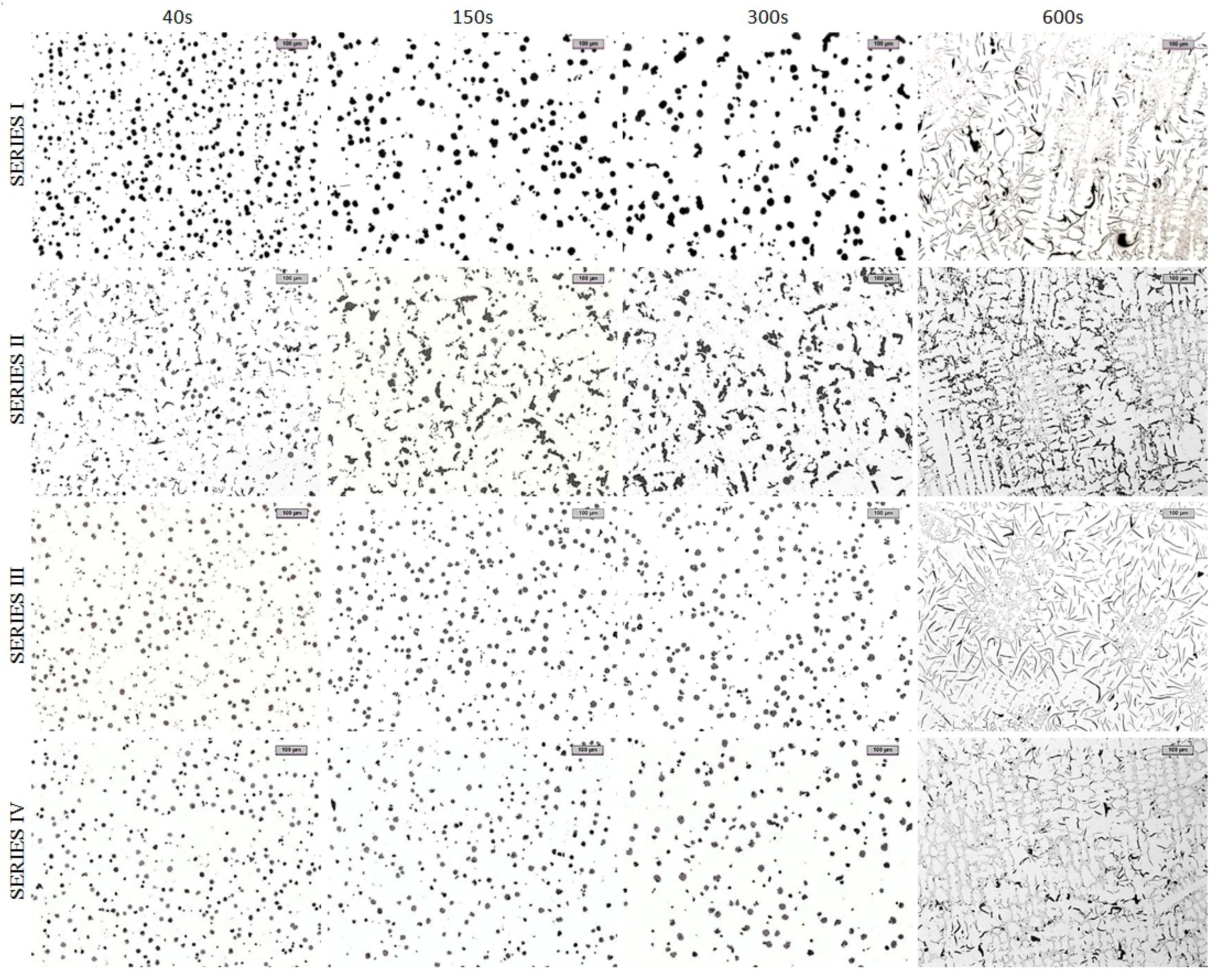
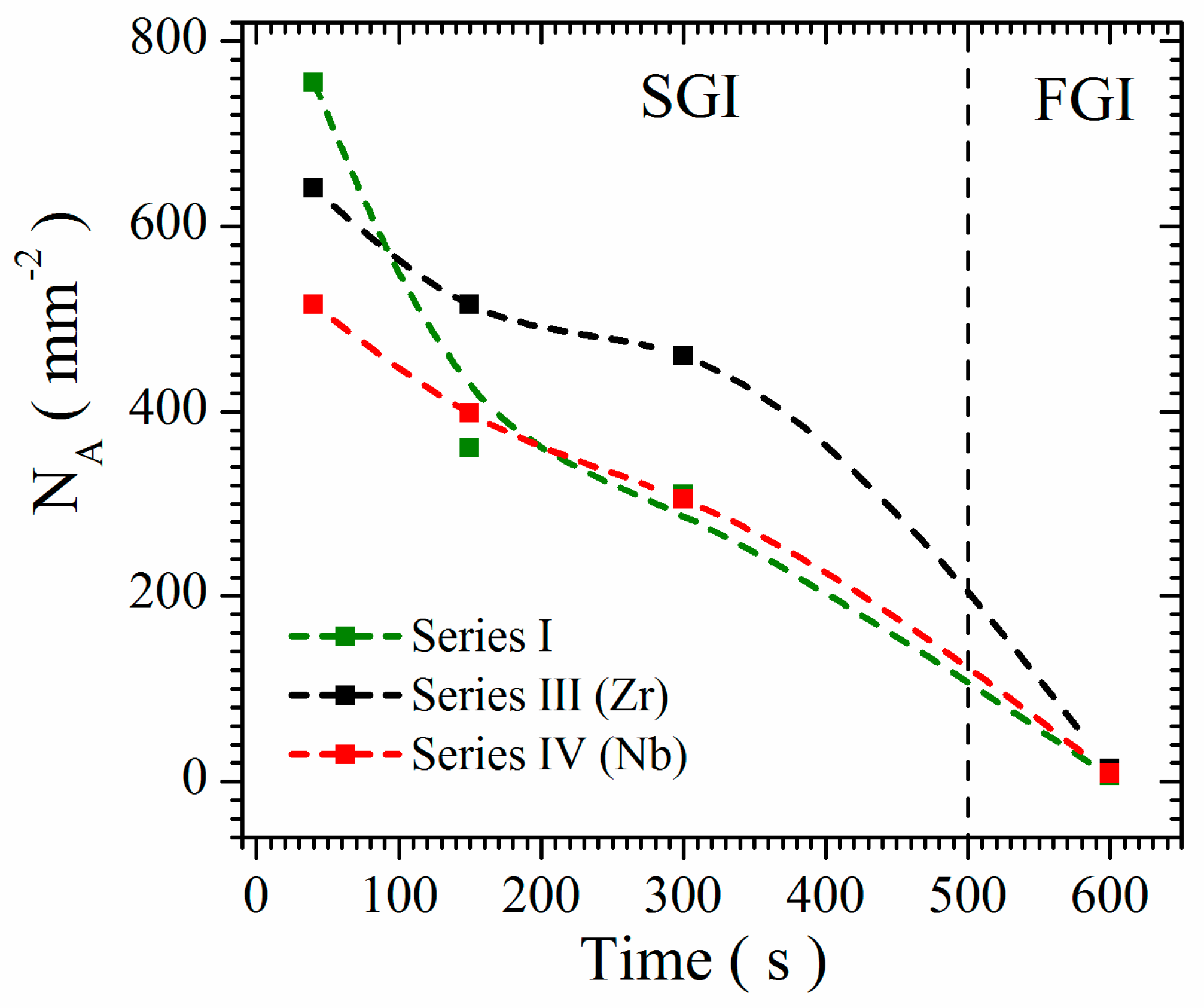
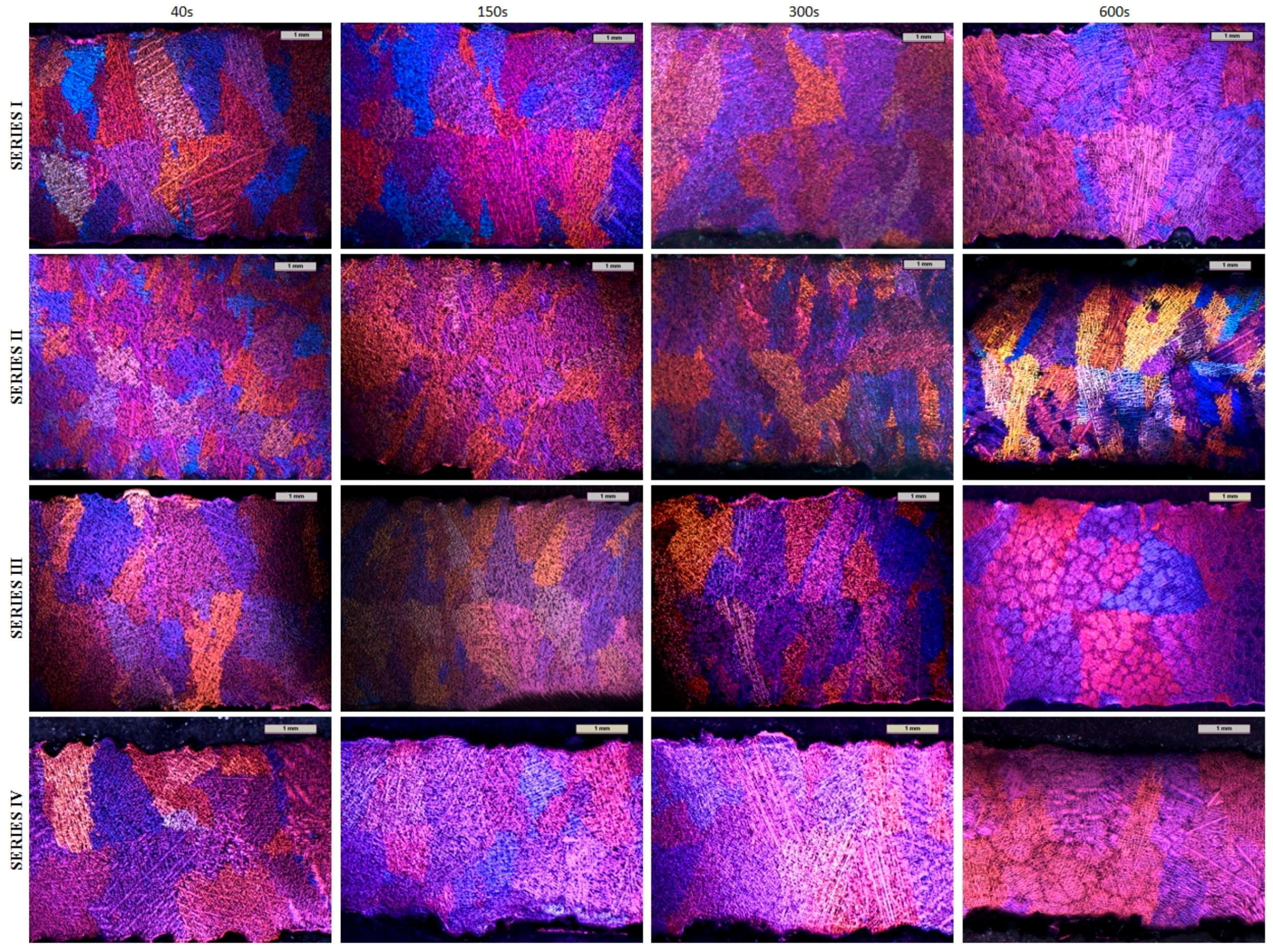
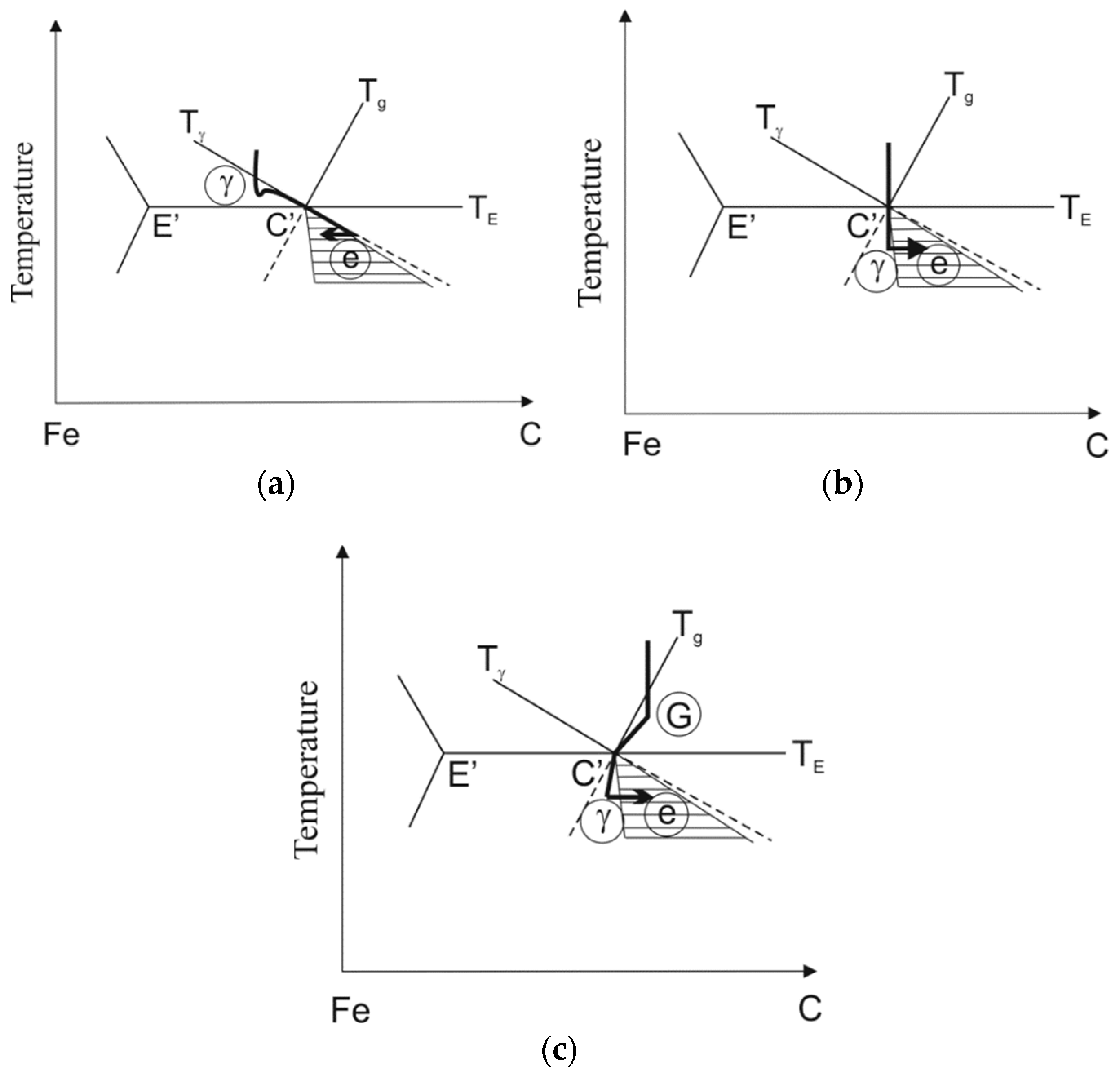
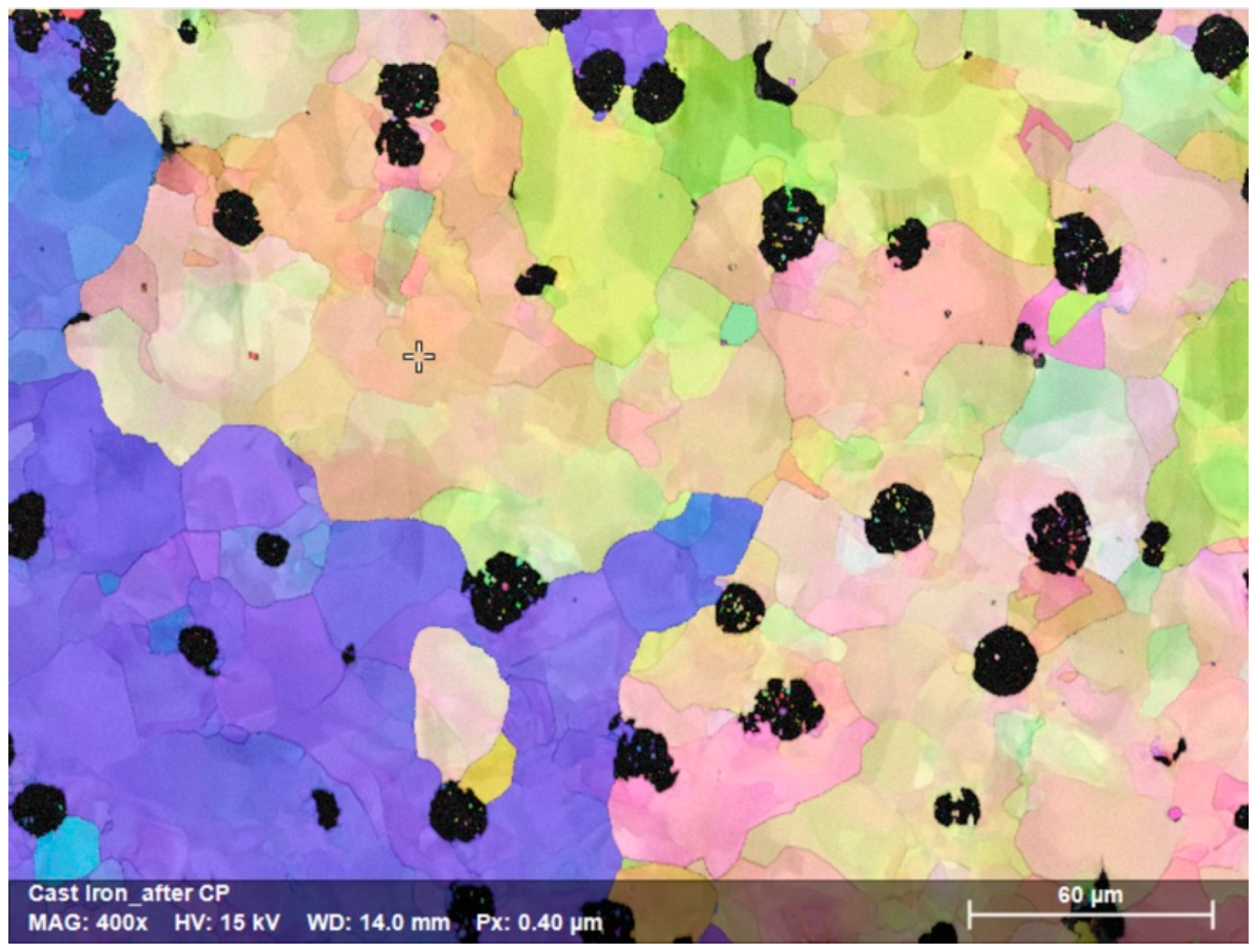
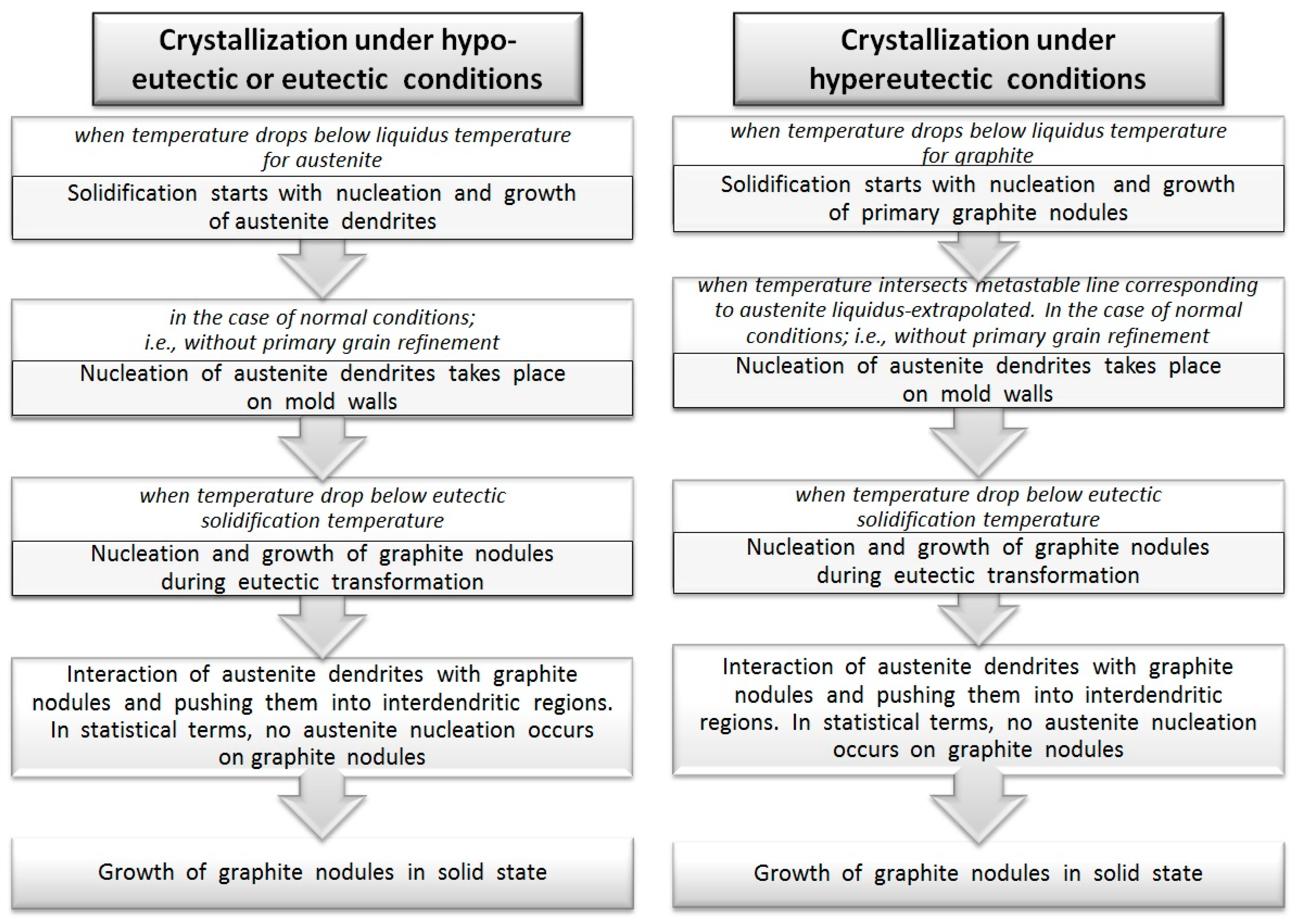
| Series No. | Element, wt.% | |||||||||
|---|---|---|---|---|---|---|---|---|---|---|
| C | Si | Ni | Mg | Mn | S | Ti | Nb | Zr | Fe | |
| I | 2.55 | 2.15 | 23.50 | 0.050 | 0.85 | 0.010 | 0.00 | 0.00 | 0.00 | Balance |
| II | 2.43 | 2.28 | 22.84 | 0.037 | 0.81 | 0.008 | 0.13 | 0.00 | 0.00 | Balance |
| III | 2.50 | 2.10 | 25.85 | 0.040 | 0.98 | 0.020 | 0.00 | 0.00 | 0.10 | Balance |
| IV | 2.51 | 2.05 | 24.66 | 0.042 | 1.00 | 0.003 | 0.00 | 0.11 | 0.00 | Balance |
© 2018 by the authors. Licensee MDPI, Basel, Switzerland. This article is an open access article distributed under the terms and conditions of the Creative Commons Attribution (CC BY) license (http://creativecommons.org/licenses/by/4.0/).
Share and Cite
Górny, M.; Kawalec, M.; Sikora, G.; Olejnik, E.; Lopez, H. Primary Structure and Graphite Nodules in Thin-Walled High-Nickel Ductile Iron Castings. Metals 2018, 8, 649. https://doi.org/10.3390/met8080649
Górny M, Kawalec M, Sikora G, Olejnik E, Lopez H. Primary Structure and Graphite Nodules in Thin-Walled High-Nickel Ductile Iron Castings. Metals. 2018; 8(8):649. https://doi.org/10.3390/met8080649
Chicago/Turabian StyleGórny, Marcin, Magdalena Kawalec, Gabriela Sikora, Ewa Olejnik, and Hugo Lopez. 2018. "Primary Structure and Graphite Nodules in Thin-Walled High-Nickel Ductile Iron Castings" Metals 8, no. 8: 649. https://doi.org/10.3390/met8080649






